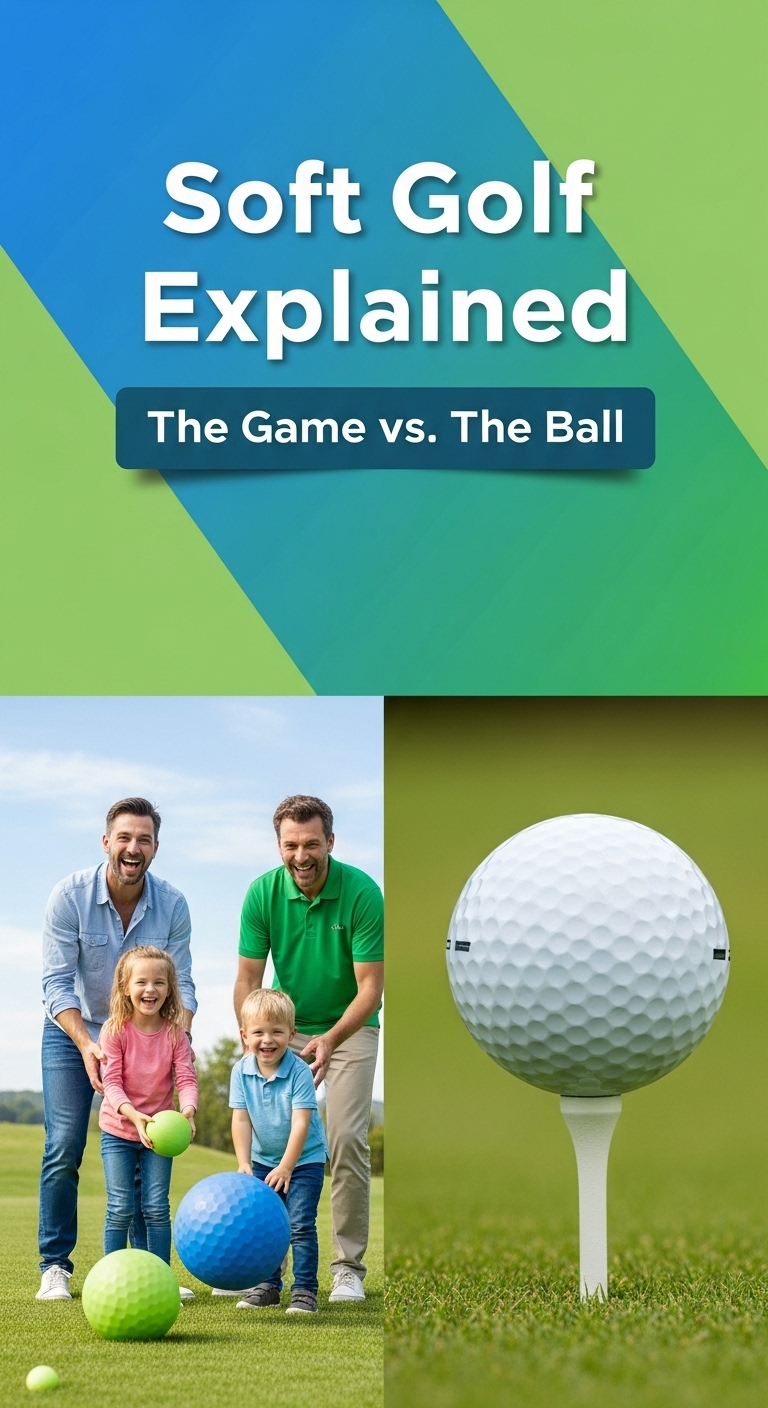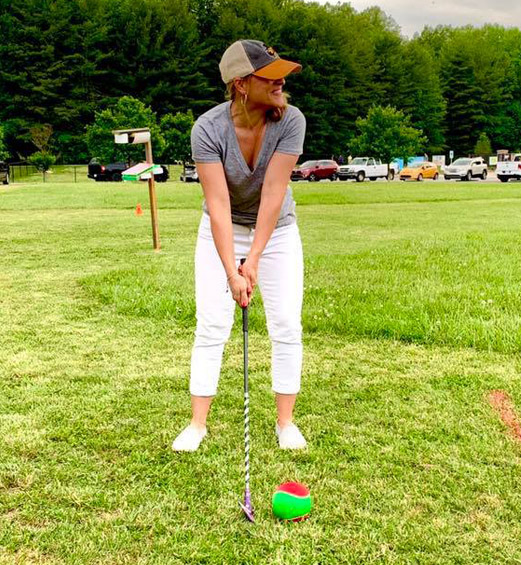As an Amazon Associate GolferHive.com earns from qualifying purchases.
Soft Golf Explained: The Game vs. The Ball
Ever heard the term ‘soft golf’ and wondered if it’s a new, gentler version of the sport or something about the equipment? You’re not alone, and the answer is… both. This common point of confusion in the golf world stems from a single term that represents two completely different concepts, leaving many players and enthusiasts searching for a clear explanation.
The term “soft golf” can refer to two distinct concepts: 1) Softgolf™, a modified, full-swing golf game with oversized equipment, and 2) soft golf balls, a category of low-compression balls used in traditional golf.
This guide will eliminate all confusion. Leveraging a deep analysis of the game, its equipment, and the balls used in traditional play, we will unpack every detail. We’ll explore the unique, fun-focused game of Softgolf™, break down the technical benefits of using soft golf balls in your regular game, and provide a clear, side-by-side comparison so you’ll never mix them up again.
Key Facts
- Oversized by Design: The Softgolf™ game intentionally uses giant 4.5-inch foam balls and massive 12-inch holes, making the game more accessible and fun than traditional golf.
- Unmatched Inclusivity: Demonstrating a powerful commitment to accessibility, the official Softgolf™ World Championship includes a division specifically for wheelchair-bound players, as highlighted by data from Softgolf.net.
- Engineered for Control: In traditional golf, soft golf balls are specifically designed for players with slower swing speeds, typically under 100 MPH, to maximize feel and forgiveness.
- A Playful Origin: The entire concept of the Softgolf™ game was born in 1974 when its founder watched his son playfully hitting a souvenir basketball with a golf club.
- Spin is the Advantage: The primary benefit of using a traditional soft golf ball is its ability to generate higher spin rates on short shots, giving players more precise control around the greens.
Part 1: Softgolf™ – The Accessible, Full-Swing Golf Game
Softgolf™ is a modified, full-swing golf game designed for fun and accessibility, using oversized clubs, giant 4.5-inch foam balls, and large 12-inch holes to make it enjoyable for all ages and skill levels, including at night. It’s a user-friendly experience that keeps the core actions of golf—driving, chipping, and putting—but removes the high-pressure, intimidating environment often associated with the traditional sport. The focus is purely on enjoyment, laughter, and creating a social outing for everyone involved.


The game was created with a clear mission: to provide an outdoor entertainment venue where people of all ages and skill levels can connect and have fun. It’s less about a perfect score and more about the shared experience.
- Equipment: The game is defined by its specialized, oversized equipment, which is designed to be easier and more forgiving to use than standard golf gear.
- Gameplay: While it uses the fundamental skills of golf, the larger targets and more manageable equipment significantly lower the difficulty, making success more frequent and the game more rewarding for beginners.
- Atmosphere: The atmosphere is relaxed and stress-free. As detailed by Forsyth County Parks & Recreation, locations like Tanglewood Park offer a vibrant setting for family outings, date nights, and team-building events.
Look: one of the most unique features is night play! The balls, flags, and even scorecard stands glow in the dark, creating a totally different kind of golf outing. Some courses are even solar-powered, highlighting an emphasis on environmental conservation.
What Makes Softgolf™ Equipment Unique?
Softgolf™ uses three oversized clubs (driver, wedge, putter), 4.5-inch glowing foam balls, and 12-inch holes to reduce the difficulty and increase the fun. This specialized gear is the key to what makes the game so approachable. Instead of a bag full of 14 complex clubs, players navigate the course with just three, each designed for a specific purpose but with a much larger, more forgiving clubface.
Quick Fact: The holes are 12 inches wide—about three times the size of a traditional golf hole—making that final putt much more satisfying!
Here is a clear breakdown of the equipment that defines the Softgolf™ experience:
| Equipment | Description | Purpose |
|---|---|---|
| Oversized Clubs | Players use a set of three proportionally large-faced clubs: a driver, a wedge, and a putter. | The larger “sweet spot” on the clubface makes it significantly easier to make solid contact with the ball. |
| Giant Foam Balls | The game is played with a durable 4.5-inch foam ball, much larger and softer than a standard golf ball. | This ball is easier to see and hit. Modern versions are designed to glow in the dark for exciting night play. |
| Large Holes | The targets on each green are 12-inch wide holes. | This drastically reduces the putting challenge, leading to more successful putts and a faster, more enjoyable pace of play. |
| Glowing Elements | The balls, flags, and scorecard stands are all designed to light up or glow. | This allows for a unique and popular nighttime version of the game, setting it apart from nearly all other golf formats. |
Who is Softgolf™ For?
Softgolf™ is designed for everyone, from children as young as three to seniors, requiring no prior golf experience and offering a stress-free environment for families, date nights, and team outings. Its core design philosophy is built on inclusivity, breaking down the barriers that can make traditional golf seem unapproachable.
The game is a perfect fit for a wide range of people and occasions:
- Beginners: For those who have never swung a club, Softgolf™ is the ideal introduction. The larger equipment makes learning the basic motions easy and rewarding.
- Families: It’s an activity that multiple generations can genuinely enjoy together, from young children to grandparents.
- Experienced Golfers: For serious golfers, it offers a fun, low-stakes way to enjoy the sport with friends or family who don’t play traditionally.
- Team Outings & Events: The social, laughter-filled atmosphere makes it a fantastic choice for corporate team-building, parties, and group events.
- Date Nights: The unique option for night play offers a memorable and interactive alternative to the usual dinner-and-a-movie.
The commitment to inclusivity is not just a marketing claim. As stated on the official Softgolf.net website, the Softgolf™ World Championship even features a wheelchair-bound division, powerfully demonstrating that the game is truly built for people of all abilities.
Part 2: Soft Golf Balls – The Feel & Control Choice in Traditional Golf
In traditional golf, “soft golf balls” are balls with a low compression rating that compress more easily on impact. They are designed for players with slower swing speeds who want better feel, more control, and increased spin on short shots around the green. Unlike the giant foam balls of the Softgolf™ game, these are standard-sized balls used in competitive and recreational golf.

The “softness” refers to the ball’s core construction. A lower compression means it takes less force to deform the ball at the moment of impact with the clubface. This characteristic leads to several performance benefits tailored to a specific type of player.
Here are the primary benefits of using a soft golf ball:
- Enhanced Feel and Control: The most cited benefit is the “cushioned” or “buttery” feel at impact. This increased deformation gives players a better sense of connection with the ball, which can translate to more precise control over their shots.
- Increased Spin Around the Greens: As noted in multiple analyses, soft balls tend to generate higher spin rates on shorter shots, like pitches and chips. This allows the ball to “bite” and stop more quickly on the green, a crucial element for a good short game.
- More Forgiveness on Off-Center Hits: Because the ball compresses more easily, it can be more forgiving on mishits. If a player fails to strike the center of the clubface, a soft ball won’t lose as much energy or fly as far offline as a firmer, high-compression ball would.
- Better Performance in Cold Weather: Golf balls tend to feel harder and fly shorter in colder temperatures. A soft ball’s lower compression helps counteract this effect, providing a more consistent feel and performance when the weather turns chilly.
Think of it like the difference between catching a softball and a baseball—the softer ball deforms more on impact, giving you a better ‘feel’ for the connection.
Who Should Use a Soft Golf Ball?
Soft golf balls are best for beginners, players with slower swing speeds (under 100 MPH), high-handicappers, and anyone who prioritizes a cushioned feel and control over maximum distance. The technical design of these balls directly addresses the needs of golfers who don’t generate elite-level clubhead speed.
Does your swing speed tend to be on the slower side, or do you prioritize a delicate touch around the greens over raw distance? If so, a soft ball might be for you. Based on a consensus from sources like Bliss Golf Shop, SwingFit, and Stix Golf, you are the ideal candidate for a soft golf ball if you fall into one of these categories:
- Players with Slower Swing Speeds: This is the primary audience. If your driver swing speed is below 100 MPH, you may not have enough force to fully compress a hard, “tour-level” ball. A soft ball is designed to compress at your swing speed, maximizing energy transfer and distance for you.
- Beginners and High-Handicappers: New players and those with higher handicaps often have less consistent swing speeds and strike patterns. The forgiveness of a soft ball on off-center hits can lead to straighter shots and better overall results.
- Seniors: Many senior golfers experience a natural decrease in swing speed. Switching to a soft ball can help them regain some of the feel and distance they may have lost.
- Players Who Prioritize Feel: Some golfers simply prefer the cushioned sensation of a soft ball at impact over the “clicky” or hard feeling of a firm ball. This is especially true for putting and chipping, where feel is paramount.
Soft vs. Hard Golf Balls: A Quick Comparison
Soft balls offer a cushioned feel and higher spin for control, while hard balls provide a firmer feel and lower spin, which can lead to more distance for players with faster swing speeds. Choosing between them is a matter of matching the ball’s characteristics to your personal swing and game priorities. There is no single “best” ball; there is only the best ball for you.
This table provides a direct, at-a-glance comparison to help you understand the trade-offs:
| Feature | Soft Golf Balls | Hard Golf Balls |
|---|---|---|
| Feel | Cushioned, soft, buttery feel at impact. | Firmer, solid, “clicky” feel at impact. |
| Spin Rate | Higher spin, especially on short shots. Good for stopping power on greens. | Lower spin, especially off the driver. Good for reducing hooks and slices. |
| Distance Potential | Maximizes distance for slower swing speeds. May feel slow or lose distance for fast swings. | Maximizes distance for faster swing speeds. Can provide more roll-out. |
| Ideal Player | Beginners, seniors, players with swing speeds under 100 MPH, those who prioritize feel. | Advanced players, players with swing speeds over 100 MPH, those who prioritize distance. |
The Key Difference: The Game vs. The Ball at a Glance
Softgolf™ is a complete, modified game focused on fun and accessibility for all, while soft golf balls are a specific type of performance equipment used within the traditional game of golf to enhance feel and control. This is the core distinction that resolves all confusion. One is an activity, the other is a piece of equipment.
This final table synthesizes all the information into a simple, definitive summary.
| Aspect | Softgolf™ (The Game) | Soft Golf Balls (Traditional) |
|---|---|---|
| What It Is | A modified, full-swing golf game played as an entertainment activity. | A category of standard-sized golf balls used in the traditional game of golf. |
| Equipment | Oversized clubs, 4.5-inch foam balls, 12-inch holes. | Low-compression, standard-size golf balls. |
| Goal / Purpose | To provide a fun, social, and accessible golf experience for everyone. | To provide players with slower swing speeds better feel, control, and forgiveness. |
| Audience | All ages (3-90+), all skill levels, families, groups, beginners. | Beginners, high-handicappers, seniors, and players with swing speeds under 100 MPH. |
To elevate your traditional golf game with the right equipment, exploring a selection of top-rated soft feel golf balls can make a significant difference in your control and confidence on the course.
FAQs About Soft Golf
Here are answers to some of the most common questions people ask when trying to understand the different meanings of “soft golf.”
What does “soft” mean in golf?
In golf, “soft” typically refers to a golf ball with a low compression rating, designed for better feel. This means the ball deforms more easily at impact, which benefits players with slower swings. However, it can also refer to Softgolf™, a modified, more accessible version of the game that uses oversized equipment.
What is the advantage of using a soft golf ball?
The main advantages of using a soft golf ball in the traditional game are a better, cushioned feel on impact and increased spin for more control on shots around the green. Additionally, they offer:
* More forgiveness on off-center hits.
* A straighter ball flight for players who don’t generate high spin.
* Better performance in cold weather conditions.
Is a soft golf ball good for beginners?
Yes, soft golf balls are generally excellent for beginners. New players typically have slower and less consistent swing speeds, and soft balls are specifically engineered for this. The added forgiveness on imperfect hits helps produce better results, which builds confidence and makes the learning process more enjoyable.
Can you play the Softgolf™ game with a traditional soft golf ball?
No, you cannot. The Softgolf™ game is a completely separate system that is designed specifically for its own oversized, 4.5-inch foam balls and large-faced clubs. A traditional, standard-sized golf ball—whether soft or hard—is far too small and would not work with the specialized equipment or the 12-inch holes.
Final Summary: Now You Know “Soft Golf”
The term “soft golf” is no longer a mystery. You now have a clear and comprehensive understanding that separates the exciting, accessible game from the technical, performance-oriented equipment. It’s a simple distinction, but one that clarifies a common point of confusion within the sport.
To recap the most critical takeaways:
- Softgolf™ is a Game: It’s an entertainment-focused activity with oversized clubs, giant foam balls, and huge holes designed for pure fun.
- Soft Golf Balls are Equipment: They are low-compression, standard-sized balls for traditional golf, engineered to give players with slower swings better feel and control.
- The Two are Incompatible: You cannot use a traditional soft golf ball to play the Softgolf™ game; each has its own specialized and incompatible equipment.
Next time you hear the term ‘soft golf,’ you’ll know exactly what to ask: “Are we talking about the game or the ball?”
Last update on 2025-12-06 / Affiliate links / Images from Amazon Product Advertising API

